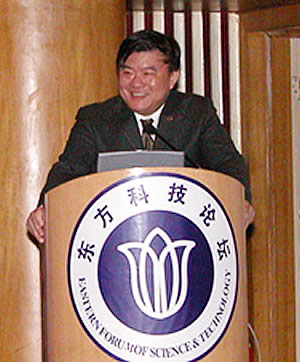
|

|
No.43 December, 2005 |
Nano-Particles Discovered to Effectively Control Tumor Growth
Research fellows of the Lab for Bio-Environmental Health Sciences of Nano-scale Materials of the Institute of High Energy Physics recently found that the surface modified nano-particles [Gd@C 82 (OH) 22 ] n do not kill the tumor cells (and normal cells as well), but exhibit very high efficiency of anti-tumor growth. Nano-particles show the high anti-tumor efficiency, strong capacity to improve immunity of tumor-mice, efficiently obstruct from tumor invasion towards normal muscle cells , and nearly without toxicity in vivo and in vitro . The project has been proposed and sponsored by Prof. Zhang Yuliang and his discovery was published on the Internet version of the US Nano Letters on Sep. 27 th . Prof. Zhao said: It is more interesting to scientists that the quantity of such kind of non-cell-killers of nano-particles are very few, only around 5 per thousand, and distribute among the tumor tissue cells. Possibly an unknown anti-tumor growth mechanism exists in this tumor controlling medical effect and it needs a in-depth study.
A China-US Joint Research Discovers Possible Origin of Cancer Cells
Prof. Shi Qinghua from the University of Science and Technology of China and Dr. Randall King of the Harvard University successfully discovered possible origin of cancer cells due to cancer infectious numerical chromosomal abnormity (so called non-euploid), providing important clues on tracing back to the origin of cancer cells, through making a movie of the human cells' division and growth process with the real-time photography technology and then, computing numerical chromosome with molecular-biotechnology. This important research achievement was published on Nature on Oct. 13 th .
The publisher's reader of the magazine believed that the research had made an obvious effect on the study of how a numerical chromosome abnormal cell was formed. It was a completely new phenomenon and would provide an important clue to trace the origin of cancer cells.
Chen Zhu Appears at China-US Chronic Disease Workshop
| Vice President Chen Zhu, CAS appeared at the meeting of the China-US Chronic Disease Workshop: Nutrition and Health on Oct. 13 th and made a speech. After the delivery of his congratulations to the success of the workshop, he commented that the studies on alcohol, obesity and diabetes were very realistic because these problems had become social challenges in China. He added that CAS attached importance to and supported the studies in the nutrition field and he hoped that the developing countries and developed countries should, hand in hand, jointly make efforts to push forward the nutrition and health programs for all peoples in the world. |  |
Pasteur Institute of Shanghai Kicks off Joint Key Research against Bird Flu
In response to the aggravating threat of the highly infectious bird flu, the Pasteur Institute of Shanghai (under preparations), CAS sponsored a meeting on Nov. 1 st with participants of the institute leaders and research group heads, discussing the key areas of the research on bird flu. The meeting worked out a decision to set up an ad hoc team composing of six research groups and put forward short- and long-term research plans. The institute decided to give research priorities to the development of a fast diagnostic system and a HA protein based new recombinant bird flu vaccine. In their near future research plans, the institute decided to set up, step by step, analytical evaluation systems and animal models. The research teams have started their initial research work and obtained some progress.
The Shanghai-based institute sponsored a one-week International Training Seminar on Bird Carrying Virus. 12 famous experts from France, US, UK, Israel, Hong Kong (SAR, China) and the mainland China participated in the Seminar and discussed the present pressing issue of the prevention and treatment of the highly lethal bird flu.
copyright © 1998-2005
CAS Newsletter Editorial Board: 52, Sanlihe Road, Beijing 100864,
CHINA
Email: slmi@cashq.ac.cn